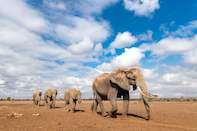
You can also easily understand why the colonials of old were so besotted with this country. There is a vast openness, a sense of freedom and the promise of wild opportunity in every direction you look.
Amboseli National Park is impressive for its wide-open vistas and plains, where tortilis or umbrella thorn trees create an archetypal African landscape. It has a vast swamp that expands and contracts with the rainy seasons. This wetland is fed by waters flowing down from Kilimanjaro, which provide both water and food for a huge abundance of wildlife and birds.
Most obvious of these are the elephants, which move out of the swamp-fringing forests early in search of new grazing each day. There are few sights in Africa more stirring than seeing a herd of giant pachyderms floating on the haze of the Amboseli plain, like ghostly, pale-grey galleons sailing in a line across a grass sea. with Kilimanjaro as the backdrop.
It has been calculated that most vertebrate animals live for around one billion heartbeats: a Shrew has a machine-gun heart rate and so lives for only a couple of years. Sluggish tortoises can live for up to three centuries. Humans and elephants have comparable lifespans,' but the elephants are governed by one other factor.
During its life, an elephant's enormous molars (typically it has only one per mandible) are replaced several times. When the last set is worn down; from a diet of rough wood and bark as well as sand in the grass they eat, they are unable to chew, lose condition and eventually die of starvation.
Along with whales and apes, elephants are regarded as having extremely high intelligence and emotional reactions. They can communicate with ultrasound over vast distances, thus keeping in touch during their wide-ranging peregrinations. The trunk is extremely sensitive, powerful and versatile.
An African elephant's trunk has two "fingers" at the end with which it can break open a peanut shell without cracking the nut. It can also lift objects as heavy as 350 kilograms. The trunk has 150,000 separate muscle groups making it an extremely complex working appendage. It is also used to break off branches and even entire trees, trumpet, drink, scratch, touch, grasp, breathe, as a snorkel (elephants are strong swimmers), like a hose and to smell. An elephant's sense of smell is about four times more sensitive than that of a bloodhound.
While in much of Africa hunting has taken a terrible toll on the elephant populations and in many areas erased the gene pool of large tuskers, Amboseli remains one of the few places where pachyderms with enormous ivory dentures (modified incisors in the upper jaw) still wander the plains. Both male and female African elephants sport tusks (in the Asian species only the males do).
Individuals are usually right- or left-tusked with the dominant one being called the master or slave tusk. Due to its overuse, that tusk will be more worn down than the other and often part of it will break off during an elephant's life.
At Satao Elerai Lodge big tuskers have right of way around camp. From early morning they begin to gather at the waterhole in front of the lodge and while individuals come and go the big-ivoried beasts dominate proceedings. The giraffes, eland, kudu and other game hang around the fringes like cross-dressers at a biker bar, while the more wily black-backed jackals play the dangerous game of darting in and out between their legs to steal a drink.
Since the establishment of the Satao Elerai Conservancy elephants have moved back and haye re-arranged the landscape significantly, as they are wont to do. In the first few years, they destroyed almost all of the large honey-nectared blackthorn (Acacia me//Lera) and fever trees (known locally as elemi, otherwise Acacia xanthophloea).
But one man's deadfall is another's windfall: it took the builders two years to gather up all the fallen timber to be used in the construction of the lodge. Trunks, branches and roots have been utilised in the most creative way for structural elements as well as fanciful fittings. The staircase in the main bar-lounge-dining area is a work of considerable structural expertise and architectural art.
On our last night there dark storm clouds rolled over the Amboseli plain. "There will snow tonight," promised the Satao Elerai lodge manager, We rose early to witness Kilimanjaro bathed in a soft golden glow, the summit cone wrapped in a frosting of snow. It seemed like a promise, like a rainbow after a thunderstorm, of better times to come.
By David Bristow

 Enjoy stunning views of Amboseli and Mount Kilimanjaro on your Kenya African safari at Elerai Camp. Watch wildlife pass by in front of your ...
Enjoy stunning views of Amboseli and Mount Kilimanjaro on your Kenya African safari at Elerai Camp. Watch wildlife pass by in front of your ...